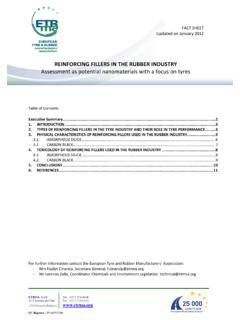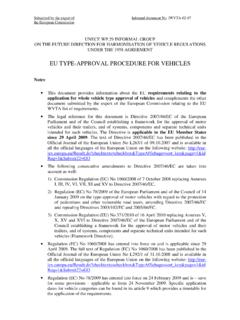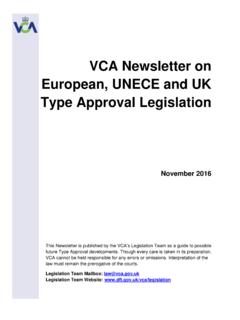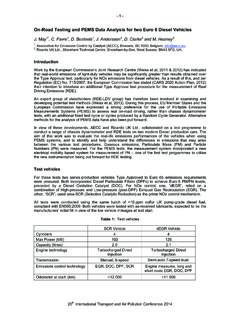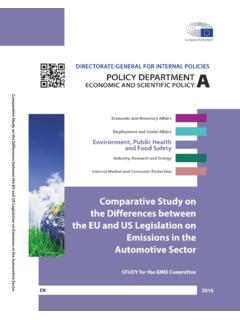Transcription of EU Tyre Labelling Regulation 1222/2009 Industry …
1 July 2012 EU Tyre Labelling Regulation 1222 / 2009 Industry Guideline on tyre Labelling to promote the use of fuel-efficient and safe tyres with low noise levels Version 4 Regulatory / Technical Questions Q1: What is the aim of the tyre labeling Regulation ? A1: The goal is to improve the safety, the economic and environmental efficiency of road transport by promoting fuel-efficient and safe tyres with low noise levels. This Regulation allows end-users to make more informed choices when purchasing tyres by considering this information along with other factors normally considered during the purchasing decision process.
2 Q2: What are the proposed tyre Labelling rules about? A2: The rules prescribe that information on certain characteristics of tyre performances will have to be communicated to consumers. This information will relate to: The impact on vehicle fuel efficiency associated to the tyre s rolling resistance The impact on vehicle safety associated to the tyre s wet grip The tyre s external noise level ( expressed in decibels); not any tyre noise heard inside the vehicle This information needs to be provided concerning passenger car tyres, light truck tyres and heavy duty vehicle tyres.
3 Q3: Do all tyres fall under the scope of the Regulation ? A3: The rules apply only to passenger car tyres (C1), light commercial vehicle tyres (C2) and heavy commercial vehicle tyres (C3). The following categories are excluded from the scope: o Retreaded tyres o Professional Off Road tyres o Racing tyres o Studded tyres (studdable tyres if supplied without studs are covered) o Temporary use spare tyres o Tyres designed to be fitted on vehicles registered for the first time before 1 October 1990 o Tyres whose speed rating is less than 80 km/h o Tyres whose nominal rim diameter does not exceed 254 mm or is 635 mm or more Q4: When will these Labelling rules apply?
4 A4: Rules will apply 1 November 2012 for all passenger car, light and heavy commercial vehicles tyres produced from 1 July 2012 (Date of Production Code 2712 ) Q5: Who should give the information to the consumer? A5: Three players have a number of obligations to ensure consumers are informed: (1) the tyre suppliers (manufacturers or importers in Europe); (2) the retailer; (3) the vehicle manufacturers 1. Tyre suppliers have to give this information in the following way: For passenger car, light truck and truck tyres the information must be available in technical promotional literature (leaflets, brochures, etc), including the manufacturer website For passenger and light truck tyres, the manufacturers or importers have the choice of either putting a sticker on the tyre tread or a label accompanying each delivery of batch of tyres to the dealer and to the end consumer 2.
5 Retailers (at point of sale): Must ensure tyres which are visible to consumers at the point of sale carry a sticker or have a label in their close proximity which is shown to the end user before the sale Page 2 of 6 Must give the information during the purchase process when the tyres offered for sale are not visible to the end-user Must give the information on or with the bill 3. Vehicle suppliers & distributors: Must declare the tyre wet grip and fuel efficiency class and external rolling noise measured value of the tyre type(s) that are offered in option, when different from those fitted normally on the basic vehicle.
6 As soon as the customer is given a choice either in the size / type of tyres fitted on the basic rim or a choice of rim and tyre size, the Labelling information must be provided before sale. There might be no obligation to provide information only in those cases where there is a choice of rim with tyres types and sizes that are strictly identical to those which are sold automatically with the new vehicle. Q6. How must the information be given to the consumers? A6. The information on the three characteristics of the tyre is given through a system of grading Wet Grip class: Even though the results* may vary according to the vehicles and weather conditions, in case of full braking, the difference between class G and A for a full set of tyres can be a 30% shorter braking distance (for example for a car driving 80 km/h, this may represent a shorter braking distance of 18m)**.
7 5 Fuel efficiency class:Even though the results* may vary according to vehicles and weather conditions, the difference between class G and class A for a complete set of tyres can reduce fuel consumption by 7,5%** and even more for trucksexternal rolling noise: the measured value in dB + 3 black waves= above the future European limit, meaning noisier, 2 black waves= between the future limit and 3dB below, meaning average tyre, 1 black wave= 3dB or more below the future limit Q7: Are there any instructions concerning the size of the label/sticker?
8 A7: Tyre suppliers do not have the freedom to decide on the size of the label. The label has a defined size (minimum width of 7,5 cm and height of 11 cm). Also, the colors and design of the label cannot be changed. Tyre suppliers also have limits on the space available to give brand information (trade name, tyre line, tyre dimension, load index, speed rating and other technical specifications). The total surface of the sticker cannot exceed 250cm2 and the sticker cannot be longer than 22 cm. Page 3 of 6 Q8: What are the values behind the rolling resistance grading?
9 The values are obtained by applying a harmonized testing method Passengercar C1 TyresLight TruckC2 TyresTruck & BusC3 TyresRR C in kg/tEnergyEfficiencyclass RR C in kg/tEnergyEfficiencyclass RR C in kg/tEnergyEfficiencyclass RRC<6,5 ARRC<5,5 ARRC<4,0A6,6 <RRC < ,6 <RRC < ,1<RRC < 5,0B7,8 <RRC < 9,0C6,8 <RRC < 8,0C5,1 <RRC < 6,0 CEmptyDEmptyD6,1 <RRC < ,1 <RRC < 10,5E8,1 <RRC < 9,2E7,1 <RRC < 8,0E10,6 <RRC < 12,0F9,3 <RRC < 10,5 FRRC >8,1 FRRC > 12,1 GRRC >10,6 GEmptyG Q9: What are the values behind the wet grip performances? The values are obtained by applying a harmonized testing method Q10: What are the values behind the noise values?
10 The values are obtained by applying a harmonized testing method = current 2001/43 limits= meets 661/ 2009 limits that will apply in the future= when tyreis 3dB(A) less than the future limits of 661/ 2009 G Wet grip class G Wet grip class G Wet grip class 1,55 G A 1,40 G A 1,25 G A 1,40 G 1,54 B 1,25 G 1,39 B 1,10 G 1,24 B 1,25 G 1,39 C 1,10 G 1,24 C 0,95 G 1,09 C Empty D Empty D 0,80 G 0,94 D 1,10 G 1,24 E 0,95 G 1,09 E 0,65 G 0,79 E G 1,09 F G 0,94 F G 0,64 F Empty G Empty G Empty G Passenger car C1 tyres Light Truck C2 tyres Truck & Bus C3 tyres Page 4 of 6 Q11: What is the status of the tests procedures for noise, rolling resistance and wet grip ?

